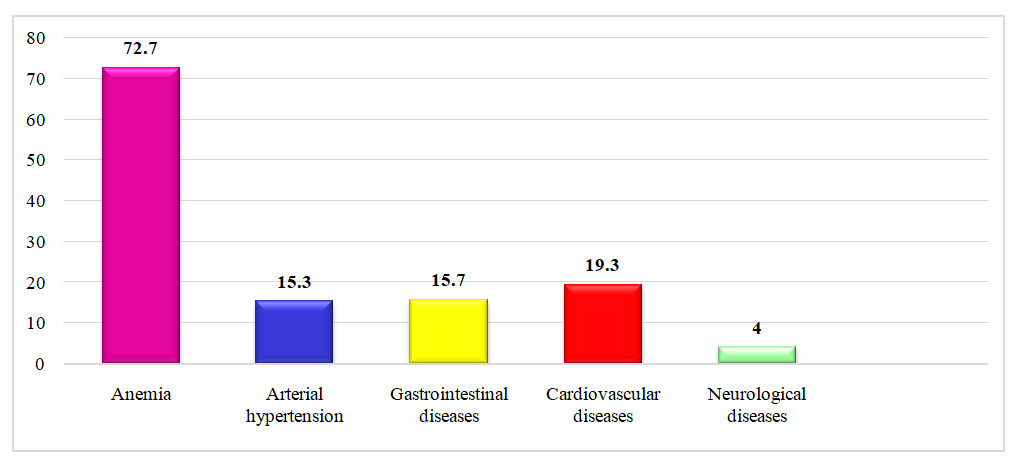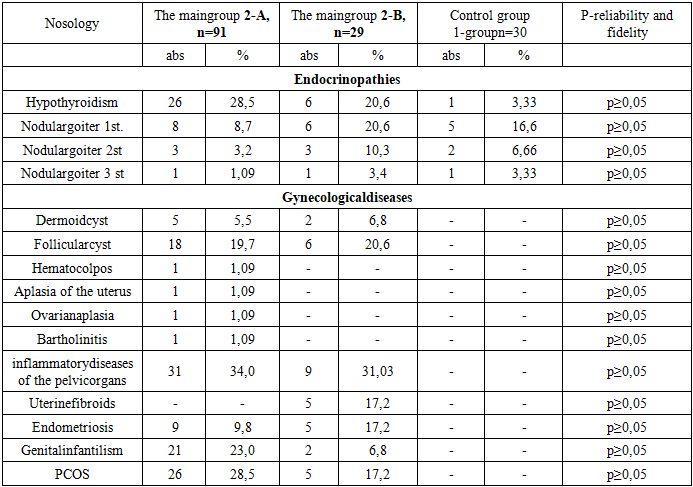-
Paper Information
- Next Paper
- Previous Paper
- Paper Submission
-
Journal Information
- About This Journal
- Editorial Board
- Current Issue
- Archive
- Author Guidelines
- Contact Us
American Journal of Medicine and Medical Sciences
p-ISSN: 2165-901X e-ISSN: 2165-9036
2025; 15(4): 930-933
doi:10.5923/j.ajmms.20251504.17
Received: Mar. 3, 2025; Accepted: Mar. 26, 2025; Published: Apr. 6, 2025

Prediction and Prevention of Reproductive Health Issues in Young Women and Adolescents
Kholovan F.
Bukhara State Medical Institute named after Abu Ali ibn Sina, Bukhara, Uzbekistan
Correspondence to: Kholovan F., Bukhara State Medical Institute named after Abu Ali ibn Sina, Bukhara, Uzbekistan.
| Email: |  |
Copyright © 2025 The Author(s). Published by Scientific & Academic Publishing.
This work is licensed under the Creative Commons Attribution International License (CC BY).
http://creativecommons.org/licenses/by/4.0/

Efforts to prevent reproductive system disorders in adolescent girls and women of early reproductive age have led to the development and implementation of predictive measures, standardized laboratory procedures, and ultrasound guidelines. Research has shown a significant association between hormonal markers (FSH, LH, estradiol, progesterone, AMH, and testosterone) and the lipid profile, as well as blood serum optical density in this group. Methodological recommendations have also been established to guide interventions. Scientific studies have confirmed that metabolic and hormonal disturbances in adolescent girls are predictive of future reproductive health issues.
Keywords: Reproductive health, Adolescent girls, Hormonal disorders
Cite this paper: Kholovan F., Prediction and Prevention of Reproductive Health Issues in Young Women and Adolescents, American Journal of Medicine and Medical Sciences, Vol. 15 No. 4, 2025, pp. 930-933. doi: 10.5923/j.ajmms.20251504.17.
1. Introduction
- Relevance of scientific workis evident in the advancements made in our republic, where new medical care standards have been developed and implemented. These standards aim to reduce the risk of gynecological diseases in their early stages and improve the prognosis of their progression. Efforts are also being made to enhance the effectiveness, quality, and accessibility of medical care, alongside standardizing diagnostic and treatment methods for tuberculosis. These initiatives reflect a commitment to improving public health outcomes.In contrast to traditional married families with children, certain models emphasize patronage and responsibilities typically associated with parenthood. This highlights the diverse structures and dynamics that can exist within family units.The aim of the study is to create an optimal framework for predicting and preventing reproductive health issues in adolescent girls and women in their early reproductive years.
2. Materials and Methods
- Disruptions in menstruation can impair reproductive function, leading to irregular menstrual cycles and affecting overall somatic health, which may paradoxically enhance reproductive capacity in some cases. We are excited to welcome women impacted by these conditions to the 2021 program, as detailed in documents 120-2019 and references [7,8].The research was carried out on the basis of the Bukhara Regional Perinatal Center, the regional reproductive center, the Regional Multidisciplinary Children's Center of Bukhara and jointly with the Department of Obstetrics and Gynecology of the Bukhara State Medical Institute for the period 2019-2021.Anamnestic data were collected from all women in the studied groups, medical history data were studied, indicators of objective studies, laboratory data and the obtained parameters of functional research methods were interpreted. In order to compile an anamnesis, complaints, information about operations, the transfer of gynecological and extragenital diseases, and the identification of the hereditary nature of the disease were taken into account. The menstrual and generative functions were studied in detail. The surveys also included data on body type, anthropometric data, and the state of the body's organs and systems. For a reliable interpretation, the nature of sensations during the menstrual cycle was clarified in detail.Statistical processing of the obtained data was carried out with the calculation of the following parameters: arithmetic mean (M), error of the arithmetic mean (t), mean square deviation, confidence interval. The Student's criterion was used to compare the averages and the degree of reliability of the differences between the samples. The differences between the indicators were considered significant if the degree of probability was p<0.05. The principle of evidence-based medicine was used in the organization and conduct of research.
3. Research Results
- In accordance with the objectives and tasks of the study, a retrospective examination of 500 girls and women aged 16 to 20 years was conducted to identify the frequency and types of menstrual disorders, study their somatic status, and determine the risk group for reproductive dysfunction. Prospectively, 120 girls and women with various menstrual disorders were examined during the period from 2019 to 2021. The control group consisted of 30 healthy women of the same age. The average age of the examined individuals was 18.0 years. More than half of the examined patients, 280 (56.0%), were rural residents, while the remaining 220 patients (44%) were permanent urban residents. The average age of patients in Group 1 was 17 ± 0.6 years, in Group 2 it was 17.9 ± 0.7 years, and in Group 3 it was 18.0 ± 0.75 years. It is evident that there is no significant difference in age or place of residence between the groups, indicating the correct selection of patients and the representativeness of the groups [1,2].Based on the obtained anamnesis data and clinical examination of the studied groups of patients, the following pathologies were identified.
|
 | Figure 1. Diagnosed concomitant diseases in the women we examined, in % ratio |
|
4. Summary
- Adolescent girls with thyroid dysfunction, obesity, somatic pathology, and menstrual disorders, regardless of their physical and sexual development stage, require necessary examination-consultation with an endocrinologist, thorough evaluation by relevant specialists, and gynecological advice to address the issue of adequate management and treatment strategies. To diagnose reproductive health disorders in girls, an ultrasound examination should be conducted to scan the uterus, ovaries, and thyroid gland, along with hormone level testing as indicated. Determining appropriate levels of Anti-Müllerian Hormone (AMH) in adolescent girls, particularly its declining trend, can predict developmental potential and reproductive disorders, especially in obese girls, and provide insight into their future reproductive capacity. Early correction of endocrine and hormonal disorders during adolescence can help avoid future reproductive problems. Addressing these issues also involves raising awareness among parents through educational efforts, emphasizing the importance of timely visits to a gynecologist one year after menarche in cases of irregular menstrual cycles, as well as early detection of weight gain or increased hair loss in their daughters.
 Abstract
Abstract Reference
Reference Full-Text PDF
Full-Text PDF Full-text HTML
Full-text HTML
